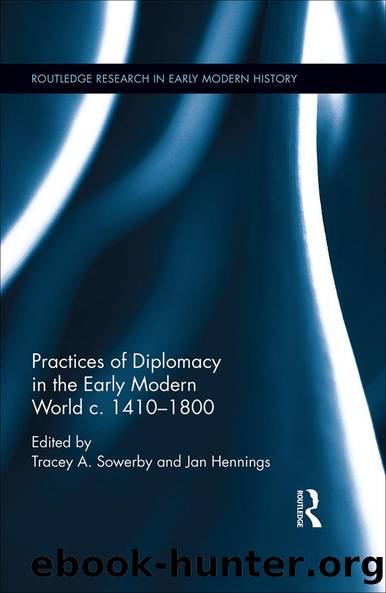Practices of Diplomacy in the Early Modern World c.1410-1800 by Tracey A. Sowerby Jan Hennings

Author:Tracey A. Sowerby, Jan Hennings [Tracey A. Sowerby, Jan Hennings]
Language: eng
Format: epub
ISBN: 9781351736909
Barnesnoble:
Publisher: Taylor & Francis
Published: 2017-05-12T00:00:00+00:00
Figure 8.2 Untitled (Shah Jahan in durbar, holding a ruby in his right hand), c. 1650. BL Add.Or.3853 fo. 1 © British Library Board, London.
The welcome given to Budaq Beg was the grandest reception accorded to any ambassador to India during Aurangzebâs reign. From the moment he crossed the SafavidâMughal border, provincial governors fêted the envoy. Outside Delhi he was warmly received by prominent courtiers who conducted him towards the Am-Khas.55 As powerful political rivals sharing close cultural and historic ties, the Mughals and Safavids turned ambassadorial exchanges into conspicuous displays of opulence and refinement. Such diplomatic trials of strength often contained barely concealed attempts to attain symbolic precedence, such as when Shah Abbas II in his letter to Aurangzeb referred to the assistance that his ancestor Shah Tahmasp had given to the exiled Mughal emperor Humayun over a century earlier.56 The large amounts of gifts, which both parties exchanged, were intended as expressions of their mastersâ power and prosperity.57 In 1661, the presents brought from Iran included sixty-six horses and a pearl weighing thirty-seven carats, representing a total value of 422,000 rupees. On his part, Aurangzeb bestowed an elaborate set of items worth 535,000 rupees on Budaq Beg, and two years later sent an embassy to Isfahan with presents worth as much as seven lakhs.58
Van Adrichemâs embassy did not come close to these dimensions. As discussed in detail in Birkenholzâs contribution, the Dutch presented Arabian horses, fine textiles, sword blades, birds of paradise, and an extensive variety of Japanese lacquer works and other rarities.59 The combined value of gifts to Aurangzeb and a range of courtiers and officials nevertheless did not exceed 27,500 guilders, out of a total expenditure of some 63,500 guilders (or around 53,000 rupees) on the mission as a whole.60 It is clear that the Dutch merchant-diplomats could not and would not compete on the level of royalty, which also would not have been expected from representatives of a minor political player with ambiguous sovereign credentials. All the same, the Company consciously selected its gifts in accordance with Mughal custom and elite tastes, demonstrating its understanding of local conventions while showcasing its distinctive character as a supplier of exotic luxury goods. Although relatively few in number and excluding cash sums, the gifts bestowed on Van Adrichem also unquestionably belonged to the classic Mughal repertoire; they included horses, jewelled daggers, and robes of honour.61 A number of discrepancies notwithstandingâprincipally the lack of reciprocity in Mughal-Dutch diplomatic exchangeâVan Adrichemâs embassy therefore, to an important extent, resembled those of other political actors in the Indian Ocean world.
Download
This site does not store any files on its server. We only index and link to content provided by other sites. Please contact the content providers to delete copyright contents if any and email us, we'll remove relevant links or contents immediately.
18 real-life stories of serial killers and murderers with solved and unsolved killings from the USA, UK, Europe, and beyond. by Ben Oakley(167)
Who's Who in the Zulu War, 1879: The British by Adrian Greaves Ian Knight(163)
Design, construction, and validation of optogenetic proteins by Colin P. O'Banion & Anwesha Goswami & David S. Lawrence(112)
The Battle of Austerlitz by 50minutes(108)
Interest and Connection in the Eighteenth Century by Jacob Sider Jost(105)
Fires of Faith by Catholic England under Mary Tudor(105)
The Seeker by S. G. MacLean(102)
The Origins of French Absolutism, 1598-1661 by Alan James(101)
Invisible Worlds by Peter Marshall(98)
The Slave Trade in Africa by Simon Webb;(96)
A Cultural History of Theatre in the Age of Enlightenment by Leon Mechele;(93)
Islam and the Trajectory of Globalization by Louay M. Safi(92)
Medicine in Modern Britain 1780-1950 by Deborah Brunton(92)
Witchcraft in Early Modern England by James Sharpe(92)
A Genius for Confusion by Richard M. Fried(90)
The Thirty Years War â Complete by Friedrich Schiller(89)
Pentecostal Republic by Ebenezer Obadare(85)
Practices of Diplomacy in the Early Modern World c.1410-1800 by Tracey A. Sowerby Jan Hennings(81)
Married Women in Legal Practice by Charlotte Cederbom(79)
